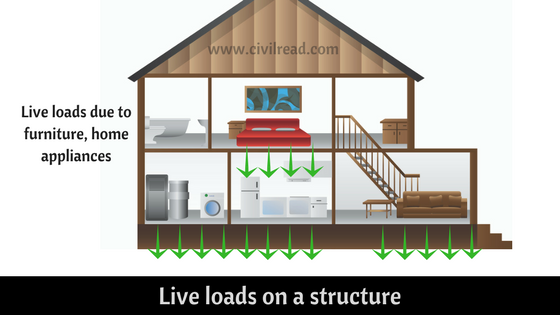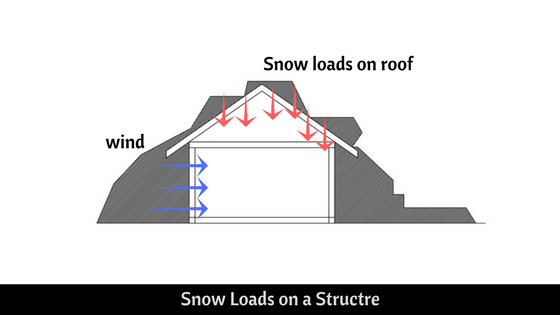Different types of loads can cause stress, displacement, deformation on a structure; which results in structural problems and even structural failure. Determining the total load acting on a structure is very important and complex.
The structure should be designed in a way that it should be enough strong to bear any type of load at any time that they are likely to face during their lifecycle.
So, the estimation of total load act on the structure or the total load that is likely to be acted on the structure in future is accurately calculated and same should be designed.
Indian standard code IS: 875–1987 and American Standard Code ASCE 7: Minimum Design Loads for Buildings and Other Structures deals with various design loads for structures.
The different types of loads acting on a structure are broadly classified into following two types
1. Vertical loads and
2. Horizontal loads

Contents
- Vertical Loads:
- Dead Loads:
- Calculation or Determination of dead loads on a structure:
- Live Loads:
- Calculation or Determination of dead loads on a structure:
- Snow loads:
- Calculation or Determination of Snow loads on a structure:
- Horizontal Loads:
- Wind loads:
- Calculation or Determination of wind loads on a structure:
- Earthquake loads:
- Some other types of loads:
Vertical Loads:
Vertical loads are further classified into following types:
Dead Loads:
These loads are permanent loads which are carried to the structure throughout their lifespan. Dead loads are also called as stationary loads. These loads occur mainly due to the self-weight of the structural members, fittings, fixed partitions, fixed equipment, etc.

For suppose, to build a column we need steel bars, concrete, shuttering, etc.
Well, concrete and bars are fixed members of the structure which are available throughout their lifespan whereas shuttering is a temporary member, which is used to keep concrete in the desired position. Shuttering is taken off from the structure after curing. From above, concrete and steel bars self-weights are considered as a dead load and load of a shuttering is not.
Calculation or Determination of dead loads on a structure:
Dead loads are calculated by estimating the quantity of each material and then multiplying it with the unit weight of that specific material.
The unit weights of different materials are tabulated below:
| Material | Unit Weight of Material |
|---|---|
| Plain Cement Concrete [PCC] | 24 kN/m3 |
| Reinforced Cement Concrete [RCC] | 25kN/m3 |
| Steel | 78.5KN/m3 |
| Brick Masonry, cement plaster | 20 kN/m3 |
| Stone Masonry | 24 kN/m3 |
| Wood | 8KN/m3 |
| Floor Finish | 0.6-1.2KN/m3 |
For suppose The column is made of Reinforced cement concrete and having a length, breadth and depth as shown in figure

then the dead load of the column is
The total volume of concrete = 3 x 0.4 x 0.4 = 0.48m3
The dead load of the column = 0.48m3 x 25KN/m3 = 12KN
Live Loads:
As the name itself resembling that these type of loads are real-time loads. Live loads are also called as imposed or sudden loads. Live loads changes with respect to time. This type of loading may come and go. For example, At one moment the room may be empty hence the live load is zero. If the same room is packed with the people, then the live load intensity will vary considerably. The live load includes the weight of furniture, people occupying the floor, etc.

Calculation or Determination of dead loads on a structure:
Live loads are considered and added to the total load acting on a member at the time of designing of the building. Some of the common live load values used in the design of buildings are tabulated below:
| Types of floors | Minimum Live load KN/m2 |
|---|---|
| Floors in houses, hospital wards, dormitories | 2.0 |
| Office floors other than entrance halls | 2.5 & 4.0 2.5 when separate storage facility provided, otherwise 4.0 |
| Shops, educational buildings, assembly buildings, restaurants | 4.0 |
| Banking halls, office entrance halls | 3.0 |
| office floors for storage, assembly floor space without seating, public rooms in hotels, dance halls, waiting halls | 5.0 |
| Ware houses, workshops, factories | Light wt loads- 5.0 Medium - 7.5 Heavy - 10.0 |
| Garages | 4.0-7.5 |
| Stairs, landings, balconies and corridors for floors but not liable to overcrowding | 3.0 |
| Stairs, landings, balconies and corridors for floors liable to overcrowding | 5.0 |
| Flat slabs, sloped roofs | Access provided - 1.5 Access not provided - 0.75 |
As the dead load is individually calculated to each and every member of the building whereas for live load it is calculated on the basis of expected sudden loads on the building in future. Suppose the structure is made for cinema halls there might be an overcrowd during releases, to meet this sudden load and to keep structure safe, the live load of 5.0KN/m2 is adopted as mentioned in above table.
Snow loads:
This type of loads is considered only on the structure which receives snowfall during monsoon. Snow loads are calculated by the projections made by snow at different parts of the structure, The amount of snow load depends on the height of building, size & shape of the roof, the location of building whether it’s on the slope or not, the frequency of snow etc. The more details about snow loads are clearly mentioned IS 875 (part 4) – 1987.

Calculation or Determination of Snow loads on a structure:
The minimum snow load on any area above ground or roof area which is subjected to snow accumulation is obtained by the expression
S= μS0
Where,
S = Design snow load
μ = Shape coefficient
S0 = Ground snow load.
Horizontal Loads:
Wind loads:
This types of loads are considered in design if the height of the building is more than 15m. Wind loads are occurred due to the horizontal load caused by the wind. As an increase in using lighter materials in the construction, wind load for a building should be considered. The structure should be strong enough with the heavy dead weights and anchored to the ground to resist this wind load. If not, the building may blow away. Wind load acts horizontally towards roofs, walls and create

Calculation or Determination of wind loads on a structure:
Wind loads are considered in design if the height of the building is more than 15m. The intensity of wind load depends upon the velocity of wind, size, and height of the building.
To calculate the design wind pressure or a total load of wind on a building the following expression is used
Pz = 0.6 Vz2
Where Pz Is in N/m2 at height Z and Vz is in m/sec.
Up to the height of 30m, the wind pressure is considered to act uniformly. Above 30m the wind pressure may increases.
In order to calculate the Vz the following expression is used
Vz = k1k2k3Vb
Where
k1 = Risk coefficient
k2 = Coefficient based on terrain, height and structure size|
k3 = Topography factor
Earthquake loads:
These type of loads causes movement of the foundation of structures. Earthquake forces are internal forces that developed on the structure because of ground movements.
Three mutually perpendicular forces act on the structure during an earthquake, two horizontal forces which acts in opposite direction and one vertical force due to the weight of the structure. As vertical force doesn’t affect much during earthquake whereas two opposite horizontal forces results in movement of the building during an earthquake. These two horizontal direction forces are considered in the design.

Due to inertia, additional forces on the structure develop on the superstructure. The impact of an earthquake on structure depends on the stiffness of structure, soil media, location and height of the structure. Accordingly, the earth has been divided into several zones depending on the magnitude of an earthquake.

Consider an example of Japan which is prone to frequent earthquakes. Japan lies in a severe earthquake zone in the world. At this place, earthquake forces are strictly taken into consideration while designing a structure.
In order to compute the seismic forces acting on a structure is deduced by computing one of the below-mentioned methods.
1. Response spectrum method
2. Seismic coefficient method.
Some other types of loads:
Some other types of forces or loads that act on the structure which are taken into account in case they are liable to affect materially the safety or serviceability of structure:
- Foundation movement (IS 1904)
- Erection load (IS 875- Part2)
- Vibration, Fatigue
- Soil and fluid pressures (IS 875- Part5)
- Stress concentration effect due to point of application of load and the like.
Also read:
Different types of Bridges
Different types of Sands
For Instant updates Join our Whatsapp Broadcast. Save our Whatsapp contact +919700078271 as Civilread and Send us a message “JOIN”
Never Miss an update Click on “Allow US” and make us allow or Click on Red notification bell at bottom right and allow notifications.
Civil Read Wishes you ALL the BEST for your future..


Nice
Very good
Good work Krishna…
Dear friends am srinivasan
I reading the valuable information about types of loads I like these kind of information.
Very nice article…
Very nice, but design houses is easy, the problem come when need design machine houses eith crain rail,, big compressors foundations,(shallow or deep), pipes rack with cooler equipment over, etc, etc, is the next step…….regards
Very good sir ! Evry article are owsm
Very concise and informative, thx.
Good work …….its my pleasure to say thank u ….boz the article is very useful to me …. i always go through it
Thanks for ur comments!
EASY TO UNDER STAND YOUR NOTES
Great sir..
Could you please give the details of materials used in Shuttering, scaffolding
sure buddy
Excellent sir
thanks
Thanks for your valuable information.
thanks for your comments
Your great talented sir keep that talent
Thanks
Good work sir. Very informative.
great work god bless you 🙂
Thank u Sir
Could u explain details of Footing, Column & beam according to loads on structure (Dead+Live). Could u please explain, How to calculate and increase the size of columns & beams and its quantity and dia of bars according to barring loads.
I ll add this on my list will come up with a detailed article
Sir,
Very easy understandable your notes.Also make another notes just like this.
Sure